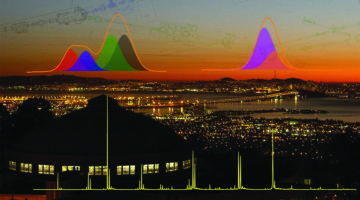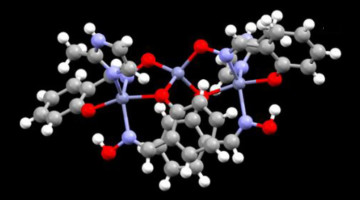The advancing in situ XAS technique made it possible to uncover the As-nZVI reaction pathway, especially capturing transient reaction process at subsecond scale. Combining the in situ XAS experimental data with computational chemistry enabled the reaction steps to be verified, clarifying the unambiguous identification of the transit reactive intermediates. Read more »
Chemical (and Strategic) Transformations at Beamline 9.0
The Chemical Dynamics beamline, used for gas-phase vacuum ultraviolet (VUV) experiments, was one of the first beamlines built at the ALS. Since then, the program has undergone several strategic transformations, enabling the study of complexity in clusters, aerosols, and nanoparticles using both VUV and soft x-ray radiation. Read more »
Key to Cleaner Combustion? Look to the Stars
Researchers made the first real-time, lab-based measurement of free radicals reacting under cosmic conditions, prompting elementary carbon and hydrogen atoms to coalesce into primal benzene rings. The findings are key to understanding how the universe evolved with the growth of carbon compounds and could also help the car industry make cleaner combustion engines. Read more »
Understanding the Hydrothermal Formation of NaNbO3: Its Full Reaction Scheme and Kinetics
To understand and tune the properties of hydrothermally produced NaNbO3, the reaction was studied in situ with powder x-ray diffraction, small-angle scattering, and total scattering with pair-distribution function analysis. The full reaction scheme and kinetics were revealed, showing two different temperature-dependent growth mechanisms. Read more »
Tuning of One Atomic Layer Unlocks Catalytic Pathway
An atomically precise surface probe helped researchers discover that a catalyst can be activated by tuning the composition of just one atomic surface layer. The work sharpens our understanding of how surface changes can improve the production of hydrogen fuel from water using efficient catalysts made of inexpensive materials. Read more »![]()
![]()
Gas-phase synthesis of corannulene—a molecular building block of fullerenes
Fullerenes have been implicated to play a key role in the astrochemical evolution of the interstellar medium. However, the formation mechanism of even their simplest molecular building block—corannulene—has remained elusive. Here we demonstrate that corannulene can be synthesized in the gas phase through reactions mimicking conditions in carbon-rich circumstellar envelopes. Read more »
Molecular Complex Removes Copper Ions from Water
X-ray analyses provided key insights into the copper uptake mechanisms in a new organic-inorganic hybrid material that quickly and selectively removes copper ions from water. The material provides an efficient tool for copper remediation as well as a blueprint for creating other hybrid materials for removing toxic metals from water. Read more »![]()
![]()
A 1-Atom-Deep Look at a Water-Splitting Catalyst
X-ray experiments revealed an unexpected transformation in a single atomic layer of a material that contributed to a doubling in the speed of a chemical reaction—the splitting of water into hydrogen and oxygen gases. This process is a first step in producing hydrogen fuel for applications such as electric vehicles powered by hydrogen fuel cells. Read more »
Extreme Low-Temperature Combustion Chemistry: Ozone-Initiated Oxidation of Methyl Hexanoate
The accelerating effect of ozone on the oxidation of methyl hexanoate was probed with time-of-flight mass spectrometry. A new oxidation regime was observed at temperatures below the well-known low-temperature chemistry regime. The results indicate that the chemistry in this regime is initiated by thermal ozone dissociation and subsequent H abstraction from methyl hexanoate by O atoms. Read more »
Rational Design of a Uranyl Metal–Organic Framework for the Capture and Colorimetric Detection of Organic Dyes
Diffraction data for a new uranyl-containing metal–organic framework reveals a structure of interpenetrating 3D nets with large pores. The material is stable in aqueous media and due to the large void space (constituting 76% of the unit cell by volume) can sequester organic dyes, the uptake of which induces a visible change to the color of the material. Read more »
- « Previous Page
- 1
- …
- 4
- 5
- 6
- 7
- 8
- …
- 13
- Next Page »









